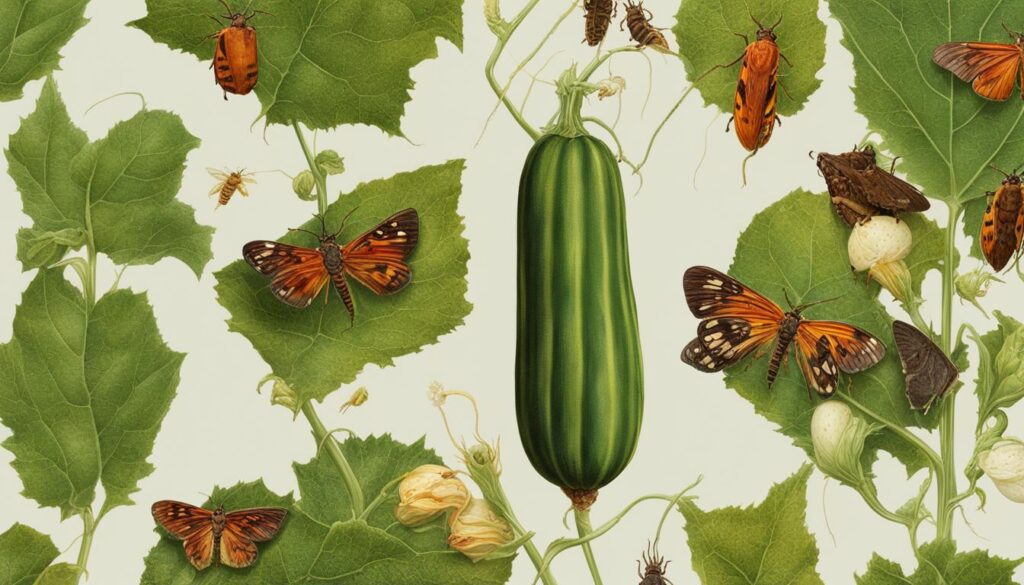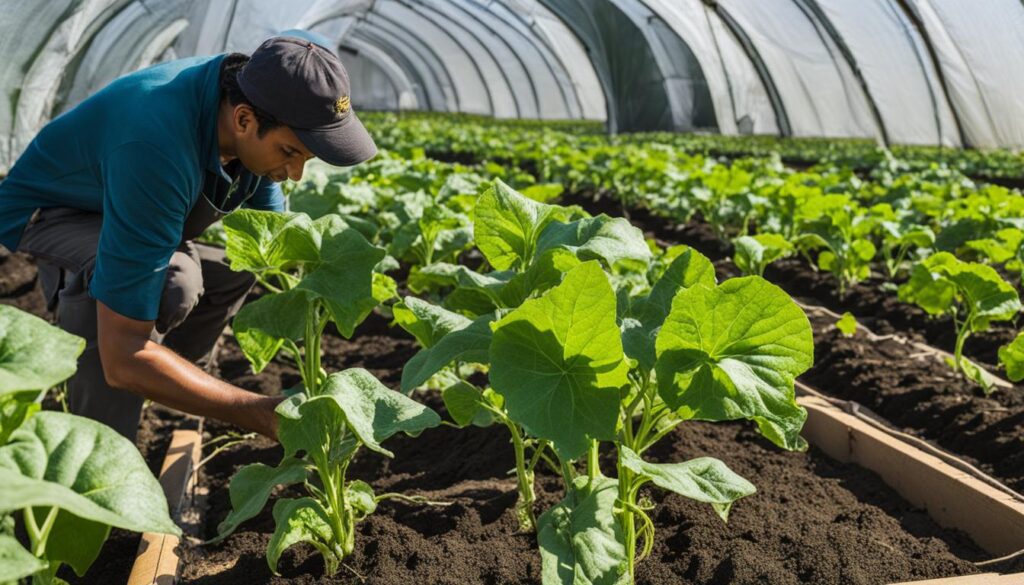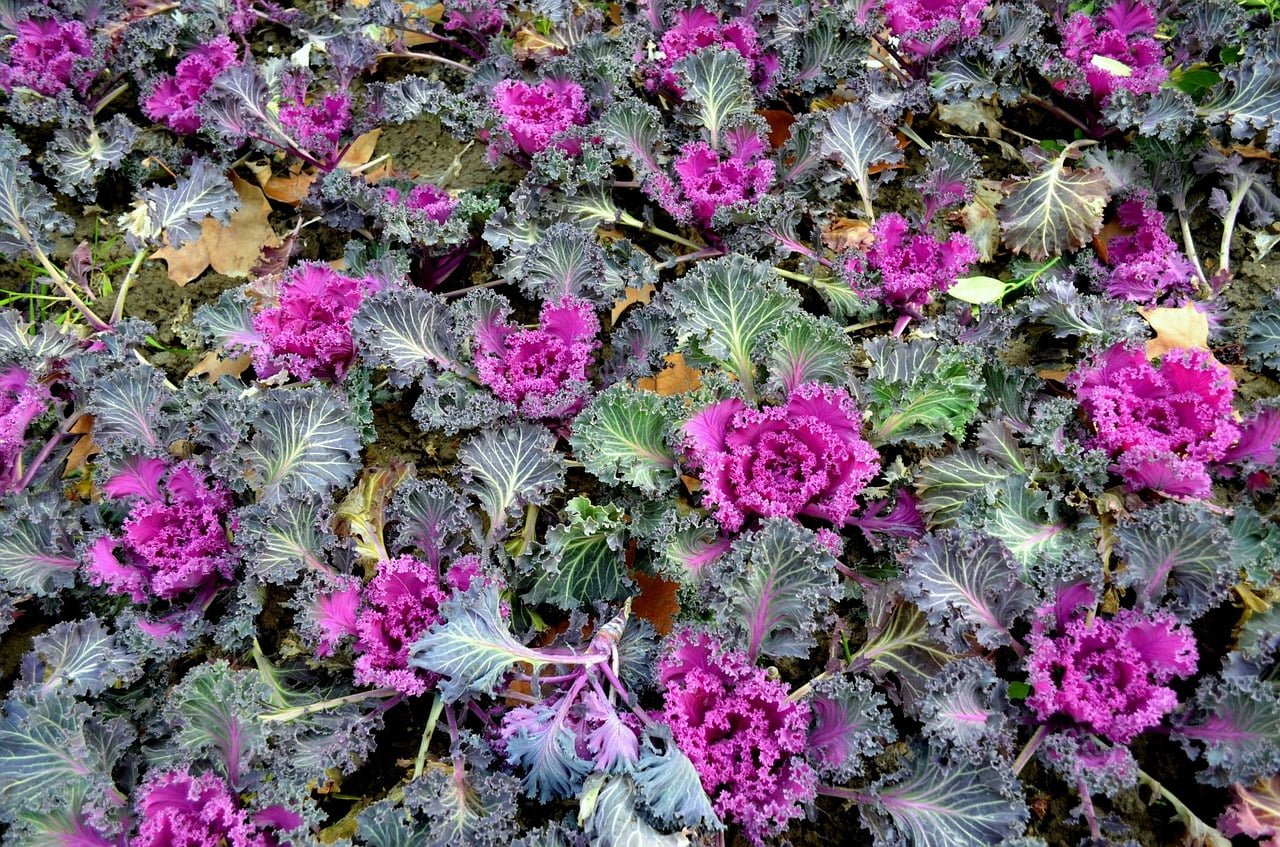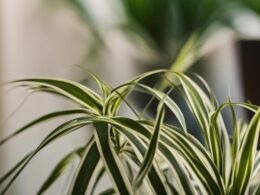If you’re a squash enthusiast, you know how frustrating it can be to see your beautiful plants suddenly wilt and die. One possible culprit could be the dreaded squash vine borer. These pests can wreak havoc on your squash plants, causing significant damage if left unchecked. But how can you know for sure if you have squash vine borers? Let’s dive into the details and learn how to identify these pests and take action to protect your plants.
Key Takeaways:
- Squash vine borers are a common pest that attacks squash plants, causing wilting and plant death.
- Identifying signs of squash vine borer infestation includes wilting, small holes and frass (sawdust-like material) around the base of the plant, and multiple borers in one stem.
- Preventive measures such as removing spent vines and planting later in the season can help reduce the risk of infestations.
- Physical and natural controls, such as introducing beneficial insects and using physical barriers, can be effective in managing squash vine borers.
- Chemical controls should be used as a last resort and with caution, considering their impact on beneficial insects.
Lifecycle and Behavior of Squash Vine Borers
The lifecycle and behavior of squash vine borers play a significant role in their impact on squash plants. Understanding these patterns can help you effectively identify and combat these pests.
The squash vine borer has a lifecycle that begins with the emergence of adult moths in late June or early July. These moths lay their eggs at the base of susceptible plants, typically on the underside of squash leaves. After about a week, the eggs hatch, and the larvae bore into the stems. This feeding activity can cause the plant to wilt as the larvae girdle the stem, impeding the flow of water and nutrients. The larvae continue to feed for four to six weeks before exiting the stems and pupating in the soil.
The adult moths of squash vine borers are about 1/2 inch long and have a distinctive appearance. They are black with orange-red markings and are known to fly during the day, mimicking wasps. These adult moths are responsible for laying the eggs that lead to future infestations.
Squash Vine Borer Lifecycle Summary:
- Adult moths emerge in late June or early July
- Eggs are laid at the base of susceptible plants
- Eggs hatch in about one week
- Larvae bore into the stems, causing wilting
- Larvae feed for four to six weeks
- Larvae exit the stems and pupate in the soil
- Adult moths emerge and repeat the cycle
Being aware of the squash vine borer lifecycle and the behaviors of adult moths, eggs, and larvae can help you take the necessary steps to prevent infestations and protect your squash plants from damage.
Signs of Squash Vine Borer Infestation
If you suspect that your squash plants are being attacked by squash vine borers, there are a few telltale signs to look out for. One of the most obvious signs is wilting of the squash plants, which may initially occur only in strong sun but eventually progresses to all-day wilting. This wilting is a result of the injury caused by the borers girdling the stem and hindering the plant’s ability to take up nutrients and water.
“The wilting may initially occur only in strong sun but eventually progresses to all-day wilting.”
In addition to wilting, look for small holes at the base of the plants. These holes are where the adult moth laid its eggs, and the resulting larvae bore into the stems. You may also notice frass, which is the sawdust-like material produced by the larvae, around the base or lower stem of the plant.
It’s important to closely inspect your squash plants for these signs to confirm if there is a squash vine borer infestation. If you notice multiple borers in one stem or find the stems becoming mushy or rotting away, it’s crucial to take immediate action to save your plants.
Damage caused by Squash Vine Borers
Squash vine borers can cause significant damage to your squash plants if left unchecked. Their feeding activity weakens the stems, leading to wilting and potential death of the plants. The borers bore into the stems, hindering the flow of water and nutrients. This can result in stunted growth, reduced fruit production, and ultimately the demise of the plant.
The holes created by the larvae serve as entry points for other pests and diseases, further compromising the overall health of the plants. Additionally, the frass produced by the larvae can attract secondary pests, such as ants or beetles, that may cause additional damage to the plants.
Preventing and Managing Squash Vine Borer Infestations
Prevention is key when it comes to managing squash vine borer infestations. By implementing preventive measures, you can reduce the risk of your squash plants being attacked. Start by practicing good garden hygiene. Remove any spent vines immediately after harvesting to eliminate overwintering borers. Tilling the soil in the affected area can also help expose any pupae, making them vulnerable to natural predators.
- Planting later in the season: Consider planting your squash later in the season, after Memorial Day, to avoid the peak period of squash vine borer activity.
- Monitoring and removing eggs: Regularly check the undersides of squash leaves for eggs and remove them promptly to prevent larvae from hatching.
- Using physical barriers: Wrapping aluminum foil or floating row covers around the base of the plants can act as a barrier, preventing the adult moths from laying their eggs.
- Implementing crop rotation: Avoid planting squash in the same area for consecutive years to disrupt the borer’s life cycle and reduce the risk of infestation.
By being vigilant and taking proactive measures, you can protect your squash plants from squash vine borers and ensure a healthy harvest.
Preventing Squash Vine Borer Infestations
To protect your squash plants from the dreaded squash vine borer, it’s crucial to implement preventive measures. Here are some effective strategies to keep these pests at bay:
- Remove spent vines: After harvesting your squash, promptly remove and dispose of the vines. This helps eliminate any remaining squash vine borers and reduces the risk of infestation in the future.
- Till the soil: By tilling the area where the vines were growing, you bring any borers in the soil to the surface. This exposes them to natural predators like birds, helping to control the population.
- Plant later in the season: Consider planting your squash later in the season, after Memorial Day. This timing helps you avoid peak squash vine borer activity, decreasing the likelihood of infestation.
- Monitor for eggs: Regularly inspect your squash plants for the presence of squash vine borer eggs. These small, brownish-red eggs are usually laid on the undersides of leaves. If you spot any, remove them immediately to prevent hatching.
- Use foil as a barrier: Create a physical barrier around the base of your squash plants by wrapping aluminum foil around the stems. This can deter squash vine borers from laying their eggs and burrowing into the plants.
By following these preventive measures, you can significantly reduce the risk of squash vine borer infestations and protect the health of your squash plants.
Quote:
“Taking proactive steps to prevent squash vine borer infestations is key to maintaining the vitality of your squash plants. By removing spent vines, tilling the soil, planting strategically, monitoring for eggs, and using foil as a barrier, you can keep these pests at bay and enjoy a thriving squash harvest.”
In summary:
- Remove spent vines after harvest.
- Till the soil to bring borers to the surface.
- Plant squash later in the season to avoid peak borer activity.
- Monitor for squash vine borer eggs and remove them promptly.
- Use aluminum foil as a physical barrier around the plants’ base.
Natural and Physical Controls for Squash Vine Borers
Squash vine borers can be effectively managed through various natural and physical controls. These methods focus on reducing the population of borers and preventing them from infesting your squash plants. By implementing these controls, you can protect your plants and ensure a healthy harvest.
Beneficial Insects
One natural control method is the introduction of beneficial insects into your garden. Parasitic wasps are known to prey on squash vine borers, helping to keep their population in check. By attracting these beneficial insects to your garden through the use of flowers and companion plants, you can create a natural balance and reduce the risk of infestations.
Manual Removal and Inserting Wire in Stems
If you spot squash vine borer larvae in your plants, manual removal can be an effective physical control. Slit open the stem and carefully remove the larvae by hand. This method helps to eliminate the borers before they can cause further damage. Another physical control technique is inserting a wire into the stems to kill the larvae. By carefully puncturing the stems, you can eliminate the borers and protect the plants.
Using Diatomaceous Earth
Diatomaceous earth is a natural product made from fossilized remains of tiny aquatic organisms called diatoms. It works by dehydrating and killing the squash vine borer larvae upon contact. Sprinkle the diatomaceous earth around the base of your squash plants, focusing on the stems. This physical barrier can deter the borers from infesting the plants and provide an added layer of protection.
Chemical Controls for Squash Vine Borers
When it comes to managing squash vine borers, chemical controls can be an effective option. However, it’s important to use them judiciously and with caution, taking into consideration their impact on beneficial insects and the environment. Here are some commonly used insecticides for squash vine borers:
- Bacillus thuringiensis v. kurstaki (Bt): This natural insecticide is derived from a soil bacterium and is effective against squash vine borers. It can be injected into the stems or applied topically to control the larvae.
- Carbaryl: This broad-spectrum insecticide is commonly used for controlling various garden pests, including squash vine borers. It can be applied as a spray or dust, targeting the base of the plants where the borers lay their eggs.
- Permethrin: Another commonly used insecticide, permethrin, can effectively control squash vine borers. It is available in various formulations, such as dust, spray, or granules. Follow the manufacturer’s instructions for proper application.
It’s important to note that timing is crucial when using chemical controls. Apply the insecticides when the eggs are hatching to target the young larvae and prevent them from burrowing into the stems. Always read and follow the label instructions, including the recommended application rates and safety precautions.
Keep in mind that while chemical controls can be effective in managing squash vine borers, they should be used as a last resort after considering other preventive and natural control methods. It is essential to strike a balance between controlling the pests and preserving the health of beneficial insects, such as bees, that play a vital role in pollination.
Tips for Controlling Squash Vine Borers
If you want to effectively control squash vine borers and protect your squash plants, here are some useful tips to consider:
- Plant Early: Start planting your squash early in the season to establish strong plants before the squash vine borers become active. This will give your plants a head start and make them more resilient to infestations.
- Crop Rotation: Avoid planting squash in the same area year after year. Crop rotation helps prevent overwintering pupae from causing infestations. By moving your squash plants to a new location each year, you can disrupt the life cycle of squash vine borers and reduce the risk of infestation.
- Use Physical Barriers: Physical barriers such as row covers or foil can be effective in preventing squash vine borer egg-laying and protecting your plants. These barriers create a physical barrier between the adult moths and your squash plants, reducing the chances of infestation.
- Plant Trap Crops: Consider planting trap crops, such as Hubbard squash, near your main crop of squash. Trap crops attract squash vine borers away from your desired plants, effectively diverting their attention and reducing the risk of infestation.
- Wood Ashes: Sprinkling wood ashes around the stalks of your squash plants can act as a natural deterrent for squash vine borers. The alkaline nature of wood ashes repels the moths and larvae, making your plants less appealing to them.
By implementing these tips, you can significantly improve your chances of controlling squash vine borers and ensuring a healthy harvest of your squash plants.
Expert Tip: Crop Rotation
“Crop rotation is a simple yet effective method to prevent squash vine borer infestations. By moving your squash plants to a different location each year, you reduce the risk of overwintering pupae hatching and infesting your new crop. It’s an important practice for maintaining the health and productivity of your squash plants.”
Expert Tip: Using Row Covers
“Row covers provide a physical barrier that prevents the adult squash vine borers from laying eggs on your plants. It’s best to place the covers over your plants immediately after planting and secure the edges to prevent any gaps. Remember to remove the covers once the plants start flowering to allow for pollination.”
Conclusion
In conclusion, squash vine borers can cause significant damage to your squash plants, leading to wilting and eventual plant death. It is important to be able to identify the signs of squash vine borer infestation and take immediate action to prevent further damage.
By implementing preventive measures such as removing spent vines, tilling the soil, and planting later in the season, you can reduce the risk of infestations. These measures disrupt the lifecycle of the squash vine borer and make it less likely for them to attack your plants.
Furthermore, natural and physical controls like introducing beneficial insects and using physical barriers can be effective in managing squash vine borers. These methods help to reduce the population of borers and protect your plants from infestation.
Finally, it is important to consider chemical controls as a last resort and use them with caution, taking into account their potential impact on beneficial insects like bees. Always read and follow label instructions when using insecticides to ensure their safe and effective application.
How Do Squash Bug Eggs Compare to Squash Vine Borer Infestation?
When it comes to spotting squash bug eggs, they are usually found on the undersides of leaves in clusters. Squash vine borer infestation, on the other hand, can cause wilting and vine damage. Both can be detrimental to squash plants, but their signs and symptoms differ.
FAQ
How can I identify if I have squash vine borers?
Look for signs such as wilting squash plants, small holes at the base of the plant, and frass (sawdust-like material) around the base or lower stem of the plant. Multiple borers in one stem can also indicate an infestation.
What is the lifecycle and behavior of squash vine borers?
Adult squash vine borers emerge from cocoons in the ground in late June or early July. They lay eggs on the underside of squash leaves, which hatch into larvae that bore into the stems to feed. After feeding for four to six weeks, the larvae exit the stems and pupate in the soil. The adult moths mimic wasps and fly during the day.
What are the signs of squash vine borer infestation?
The most obvious sign is wilting of squash plants, which may start in strong sun and progress to all-day wilting. Other signs include small holes at the base of the plants and frass (sawdust-like material) around the base or lower stem. The stems may also become mushy or rot away.
How can I prevent squash vine borer infestations?
Measures to prevent infestations include removing spent vines immediately after harvesting, tilling the area to bring any buried borers to the surface for birds to feed on, planting squash later in the season, monitoring for eggs and removing them, and wrapping foil around the stem as a barrier.
What are natural and physical controls for squash vine borers?
Natural controls include introducing beneficial insects like parasitic wasps, manually removing larvae from the stems, and using diatomaceous earth or black pepper as a deterrent. Physical controls include inserting a wire into the stem to kill the larvae and sprinkling wood ashes around the stalks.
Are there chemical controls for squash vine borers?
Yes, insecticides can be used when eggs are hatching to effectively control squash vine borers. Options include Bacillus thuringiensis v. kurstaki (Bt), carbaryl, permethrin, bifenthrin, and esfenvalerate. It’s important to read and follow the label instructions and consider the impact on beneficial insects before using chemical controls.
What tips do you have for effectively controlling squash vine borers?
Plant squash early in the season, avoid planting in the same area two years in a row, use physical barriers like row covers or foil, consider planting trap crops to divert borers, and try using wood ashes as a potential control method.
What is a summary of squash vine borers and their control?
Squash vine borers are common pests that attack squash plants, causing wilting. They have one generation per year and go through different stages of development. Signs of infestation include wilting, holes in the stem, and frass around the base of the plant. Preventive measures, natural and physical controls, and chemical controls can help manage the infestation. By following these tips, you can protect your squash plants and ensure a healthy harvest.












